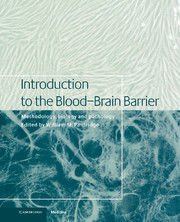Book contents
- Frontmatter
- Contents
- List of contributors
- 1 Blood–brain barrier methodology and biology
- Part I Methodology
- 2 The carotid artery single injection technique
- 3 Development of Brain Efflux Index (BEI) method and its application to the blood–brain barrier efflux transport study
- 4 In situ brain perfusion
- 5 Intravenous injection/pharmacokinetics
- 6 Isolated brain capillaries: an in vitro model of blood–brain barrier research
- 7 Isolation and behavior of plasma membrane vesicles made from cerebral capillary endothelial cells
- 8 Patch clamp techniques with isolated brain microvessel membranes
- 9 Tissue culture of brain endothelial cells – induction of blood–brain barrier properties by brain factors
- 10 Brain microvessel endothelial cell culture systems
- 11 Intracerebral microdialysis
- 12 Blood–brain barrier permeability measured with histochemistry
- 13 Measuring cerebral capillary permeability–surface area products by quantitative autoradiography
- 14 Measurement of blood–brain barrier in humans using indicator diffusion
- 15 Measurement of blood–brain permeability in humans with positron emission tomography
- 16 Magnetic resonance imaging of blood–brain barrier permeability
- 17 Molecular biology of brain capillaries
- Part II Transport biology
- Part III General aspects of CNS transport
- Part IV Signal transduction/biochemical aspects
- Part V Pathophysiology in disease states
- Index
14 - Measurement of blood–brain barrier in humans using indicator diffusion
from Part I - Methodology
Published online by Cambridge University Press: 10 December 2009
- Frontmatter
- Contents
- List of contributors
- 1 Blood–brain barrier methodology and biology
- Part I Methodology
- 2 The carotid artery single injection technique
- 3 Development of Brain Efflux Index (BEI) method and its application to the blood–brain barrier efflux transport study
- 4 In situ brain perfusion
- 5 Intravenous injection/pharmacokinetics
- 6 Isolated brain capillaries: an in vitro model of blood–brain barrier research
- 7 Isolation and behavior of plasma membrane vesicles made from cerebral capillary endothelial cells
- 8 Patch clamp techniques with isolated brain microvessel membranes
- 9 Tissue culture of brain endothelial cells – induction of blood–brain barrier properties by brain factors
- 10 Brain microvessel endothelial cell culture systems
- 11 Intracerebral microdialysis
- 12 Blood–brain barrier permeability measured with histochemistry
- 13 Measuring cerebral capillary permeability–surface area products by quantitative autoradiography
- 14 Measurement of blood–brain barrier in humans using indicator diffusion
- 15 Measurement of blood–brain permeability in humans with positron emission tomography
- 16 Magnetic resonance imaging of blood–brain barrier permeability
- 17 Molecular biology of brain capillaries
- Part II Transport biology
- Part III General aspects of CNS transport
- Part IV Signal transduction/biochemical aspects
- Part V Pathophysiology in disease states
- Index
Summary
Introduction
The terms indicator diffusion, double-indicator, single injection or indicator dilution have been used interchangeably for this technique, the principles of which were outlined by Chinard et al (1955) and first applied in the brain by Crone, who also provided the first quantitative measurements of capillary permeability and demonstrated a carrier-mediated transport of D-glucose across the Blood–brain barrier (BBB) (Crone, 1965). In 1971, the method was applied in humans by Lassen and co-authors, and later used in several clinical studies (Bolwig et al., 1977; Paulson et al., 1977; Hertz and Paulson, 1980, 1982; Knudsen et al., 1990a,b 1991, 1995; Hasselbalch et al., 1995, 1996). In 1994, the intravenous indicator diffusion method was developed (Knudsen et al.). A more detailed description of its application in humans has been given previously (Knudsen, 1994b).
The indicator diffusion technique for BBB permeability measurements has classically been applied as follows (Fig. 14.1): An intracarotid bolus injection of isotopically labeled test and BBB impermeable reference substance is given, immediately followed by a rapid series of blood sampling from the internal jugular vein in humans or from the sagittal sinus in rats. If closely matching tracer substances have been chosen and the venous concentration of each tracer is normalized with the injectate concentration then the time course of the brain outflow curves of the test and reference substances are known.
- Type
- Chapter
- Information
- Introduction to the Blood-Brain BarrierMethodology, Biology and Pathology, pp. 133 - 139Publisher: Cambridge University PressPrint publication year: 1998
- 2
- Cited by



